10x Genomics
Chromium Single Cell Gene Expression
Cell Ranger6.0, printed on 07/15/2025
Web Summary
The cellranger pipeline outputs a summary HTML file named web_summary.html that contains summary metrics and automated secondary analysis results. If an issue was detected during the pipeline run, an alert appears on this page, and more information about these is provided in the troubleshooting documentation.
cellranger count Web Summary
The run summary from cellranger count can be viewed by clicking "Summary" in the top left corner. The summary metrics describe sequencing quality and various characteristics of the detected cells. Similar web summaries are also output from the cellranger reanalyze and cellranger aggr pipelines.
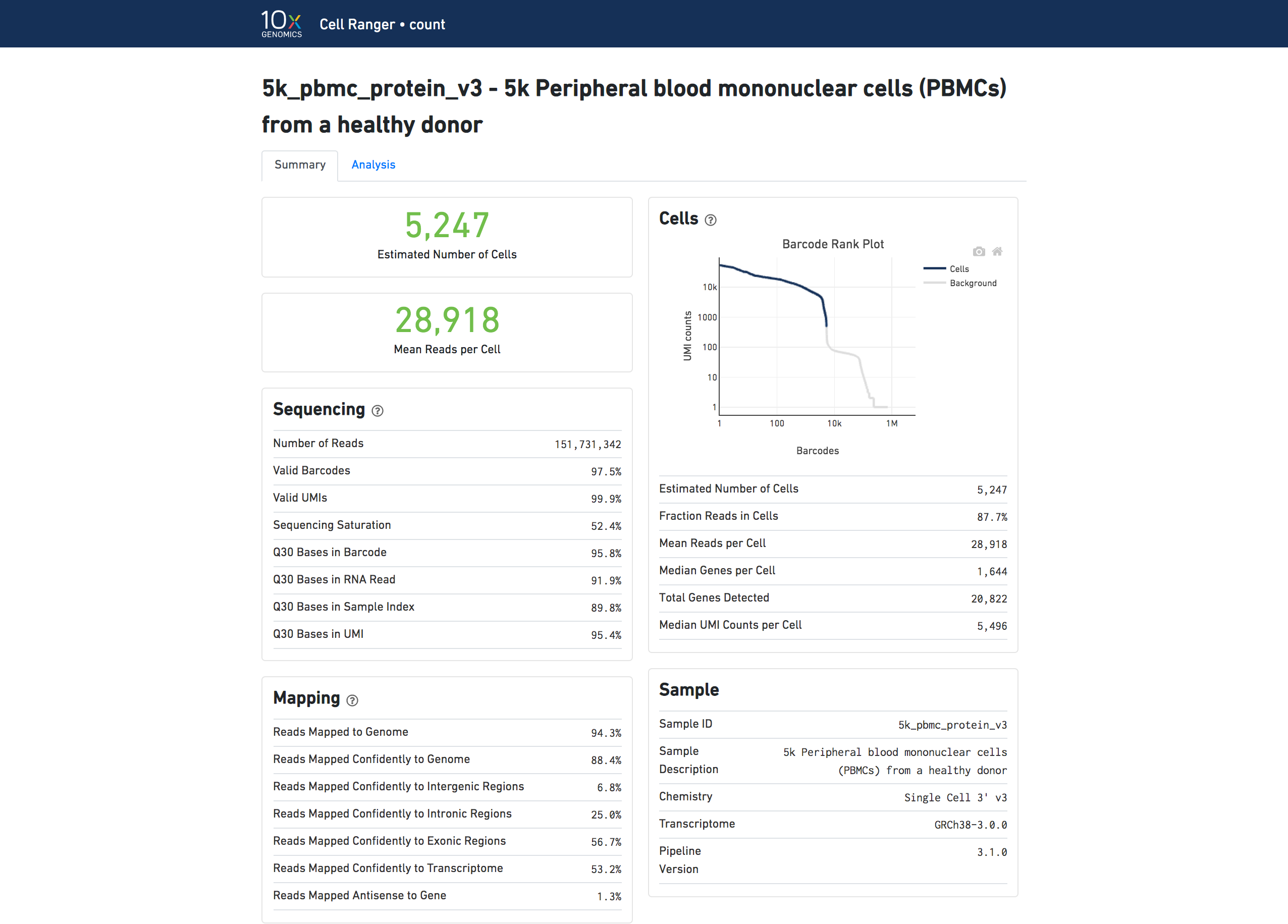
The number of cells detected, the mean reads per cell, and the median genes detected per cell are prominently displayed near the top of the page.
Click the '?' in the top of each dashboard for more information on each metric.
The Barcode Rank Plot under the "Cells" dashboard shows the distribution of barcode counts and which barcodes were inferred to be associated with cells. The y-axis is the number of UMI counts mapped to each barcode and the x-axis is the number of barcodes below that value. A steep drop-off is indicative of good separation between the cell-associated barcodes and the barcodes associated with empty partitions. Barcodes can be determined to be cell-associated based on their UMI count or by their RNA profiles, therefore some regions of the graph can contain both cell-associated and background-associated barcodes. The color of the graph represents the local density of barcodes that are cell-associated. See Cell Calling Algorithms for more details.
Analysis View
The automated secondary analysis results can be viewed by clicking "Analysis" in the top left corner. The secondary analysis provides the following:
- A dimensional reduction analysis which projects the cells into a 2-D space (t-SNE)
- An automated clustering analysis which groups together cells that have similar expression profiles
- A list of genes that are differentially expressed between the selected clusters
- A plot showing the effect of decreased sequencing depth on observed library complexity
- A plot showing the effect of decreased sequencing depth on median genes per cell detected
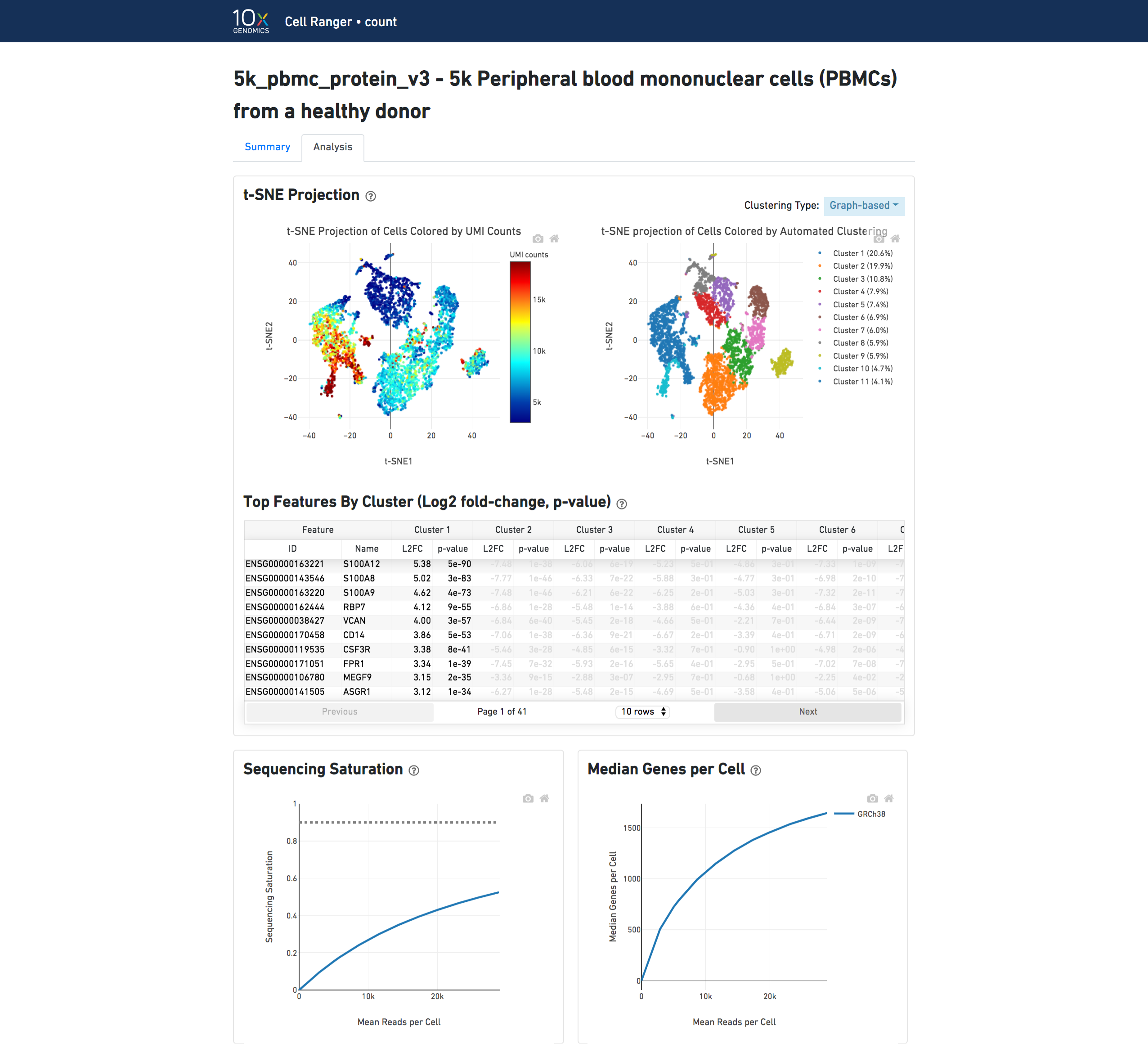
The top left plot shows the 2-D t-SNE projection of the cells colored by the total UMI counts per cell. This is suggestive of the RNA content of the cells and often correlates with cell size - redder points are cells with more RNA in them.
The top right plot overlays the clustering results onto the 2-D t-SNE projection of cells. The type of clustering analysis is selectable from the dropdown in the upper right - change this to vary the type of clustering and/or number of clusters that are assigned to the data.
The table in the middle shows which genes are differentially expressed in each cluster relative to all other clusters. To find the genes associated with a particular cluster, you can click the cluster number to sort the table by specificity for that cluster.
The bottom left plot shows the effect of decreased sequencing depth on Sequencing Saturation, which is a measure of the fraction of library complexity that was observed. The far right point of the line is the full sequencing depth obtained in this run.
Similarly, the bottom right plot shows the effect of decreased sequencing depth on Median Genes per Cell, which is a way of measuring data yield as a function of depth. The far right point is the full sequencing depth obtained in this run.
Feature Barcode View
If you use Cell Ranger to process Feature Barcode data, new metrics that are specific to the given Feature Barcode libraries will appear in summary tab.
Below is an example web summary when the Antibody Capture library type is used:
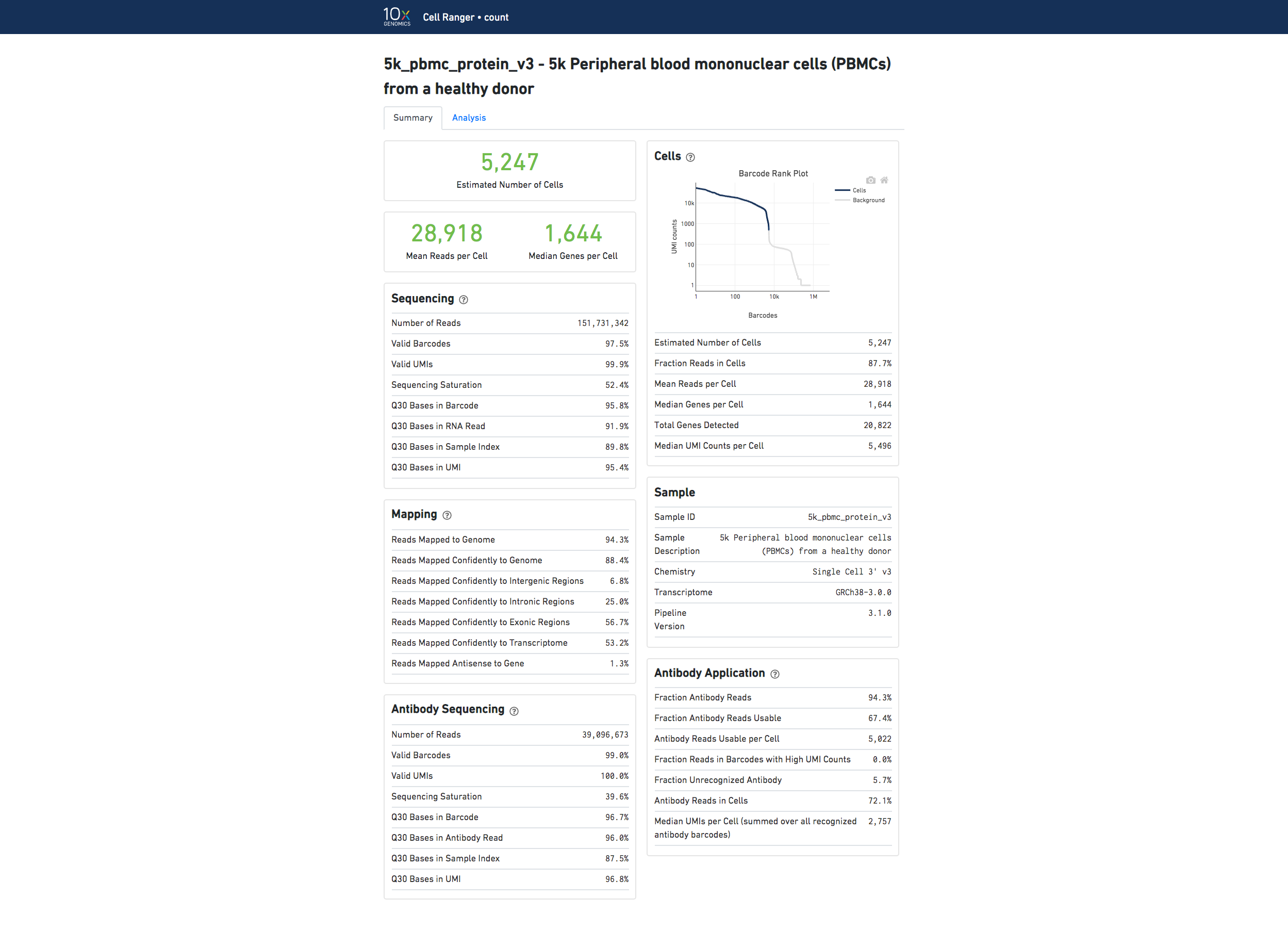
Here is an example web summary when the CRISPR Guide Capture library type is used:
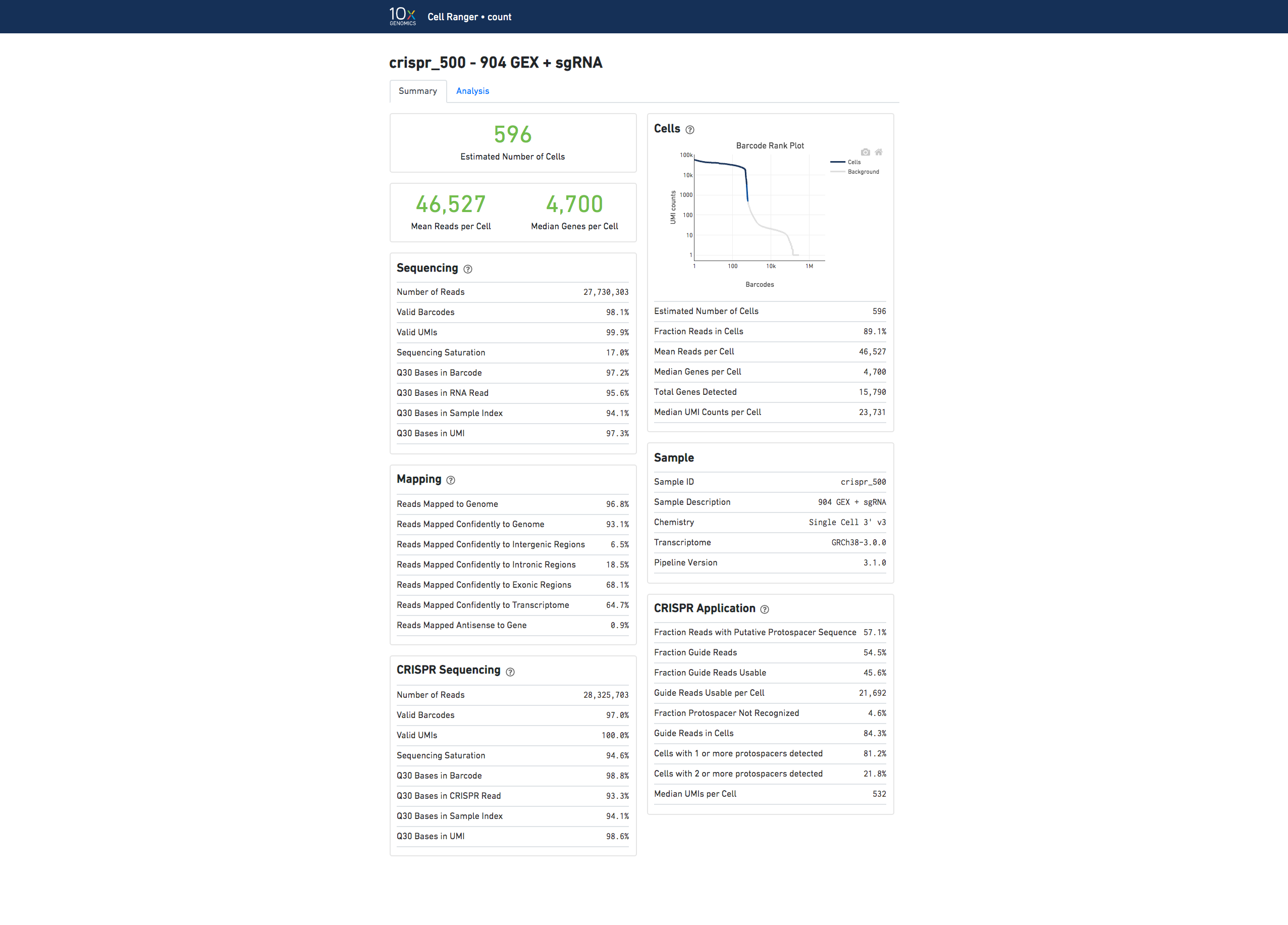
The analysis view for Feature Barcode experiments contains the same secondary analysis as purely gene expression experiments, and uses only the gene expression part of the feature-barcode matrix for dimensionality reduction, clustering, and differential gene expression analysis.
Multiple Species
If you analyzed a multi-species experiment, the output will look different. For example, the human-mouse mixing experiment is run to verify system functionality. It consists of mixing approximately 500 human (HEK293T) cells and 500 mouse (3T3) cells in a 1:1 ratio.
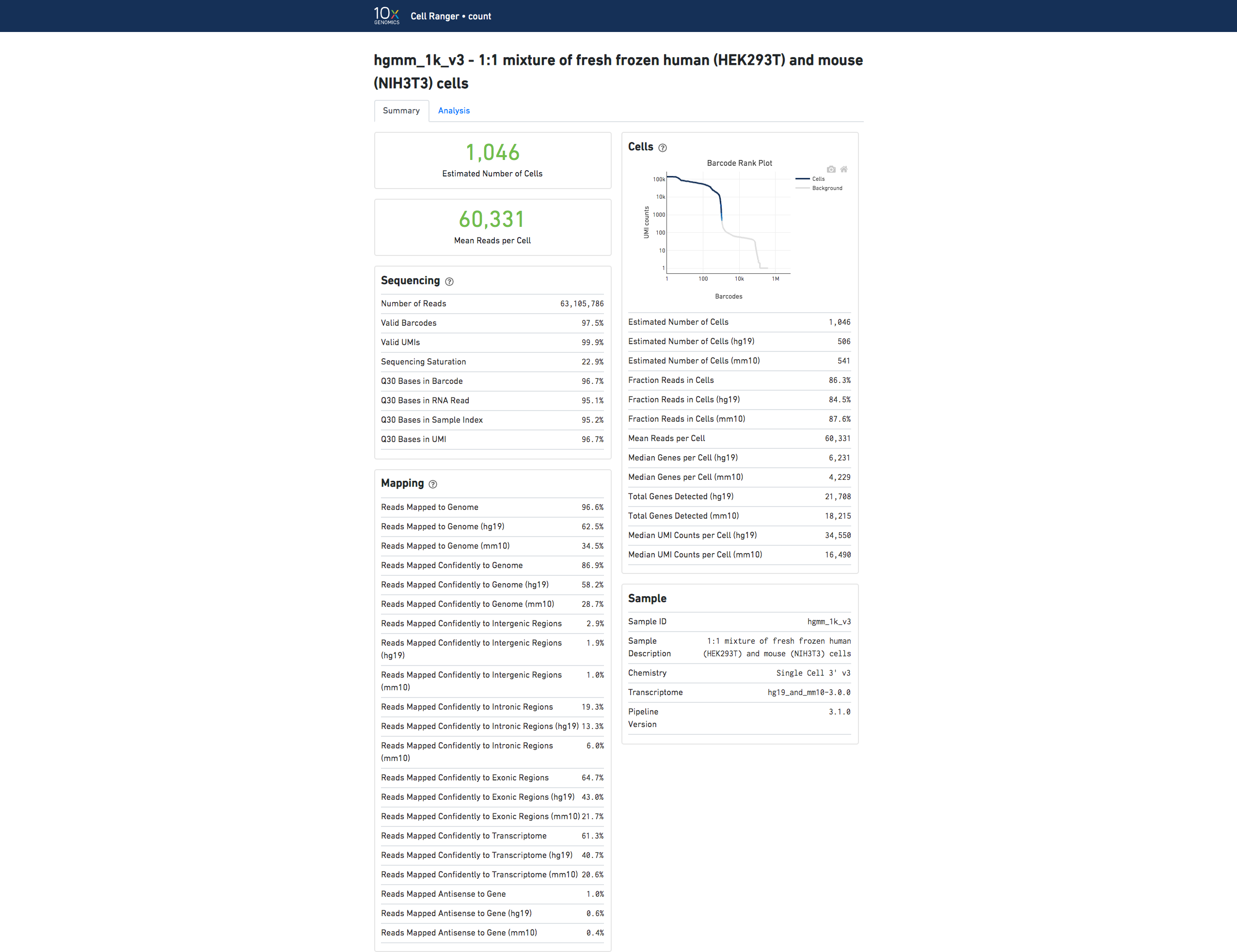
Click the '?' in the top of each dashboard for more information on each metric.
In the Analysis View, running the human-mouse mixing experiment results in the following plot:
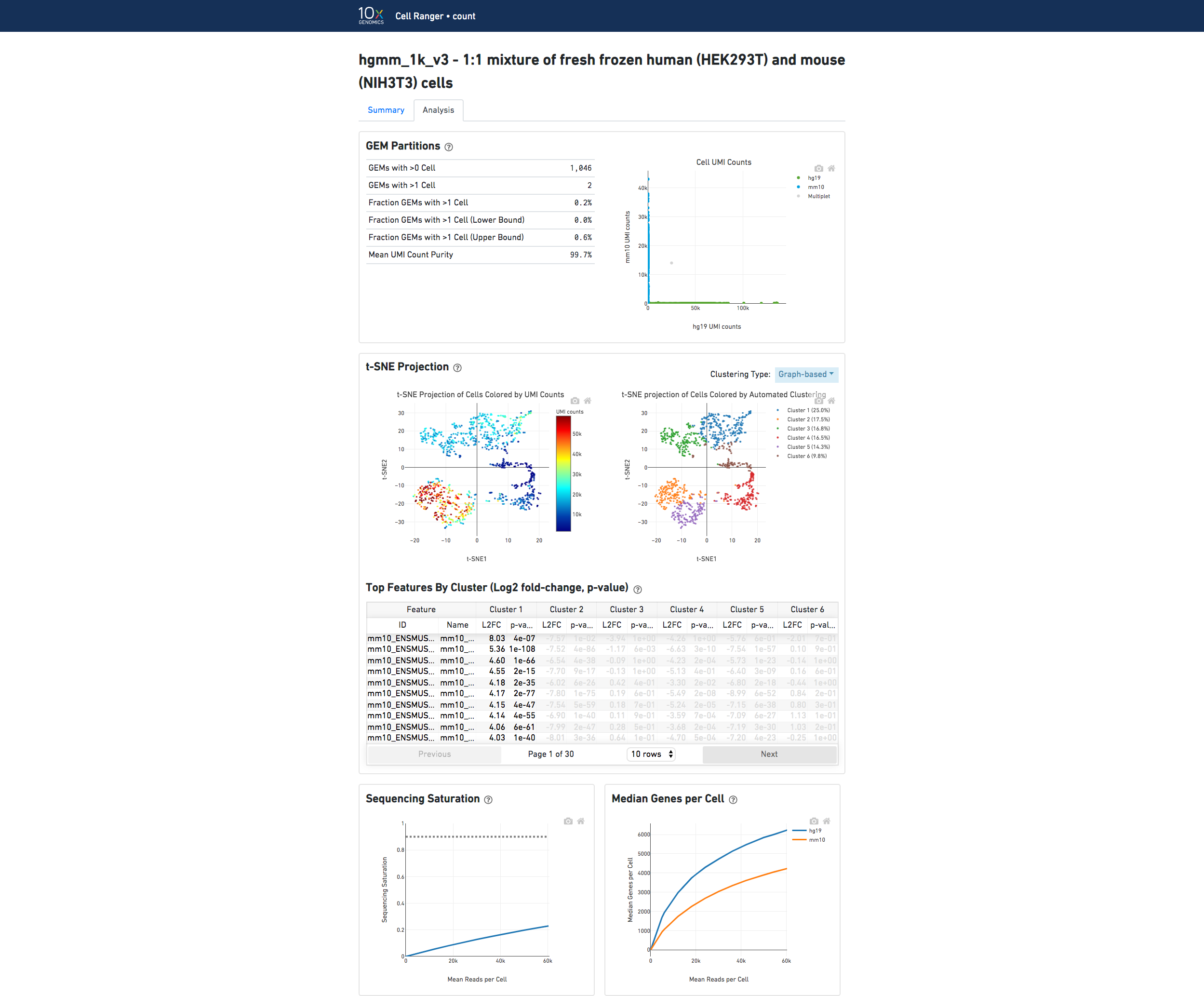
Each point represents a barcode; the gray points are inferred to be associated with GEM partitions that contained more than one cell because they contained a large number of molecules that came from human cells and mouse cells. The GEMs containing human-human and mouse-mouse cell combinations are not visible here, but their presence is inferred in the "Fraction GEMs with >1 Cell" metric shown next to the plot.
Targeted Gene Expression View
If you ran a Targeted Gene Expression experiment, the output includes modifications that highlight targeting performance. The following is an example of the Run Summary from a Cellranger Targeted Count run.
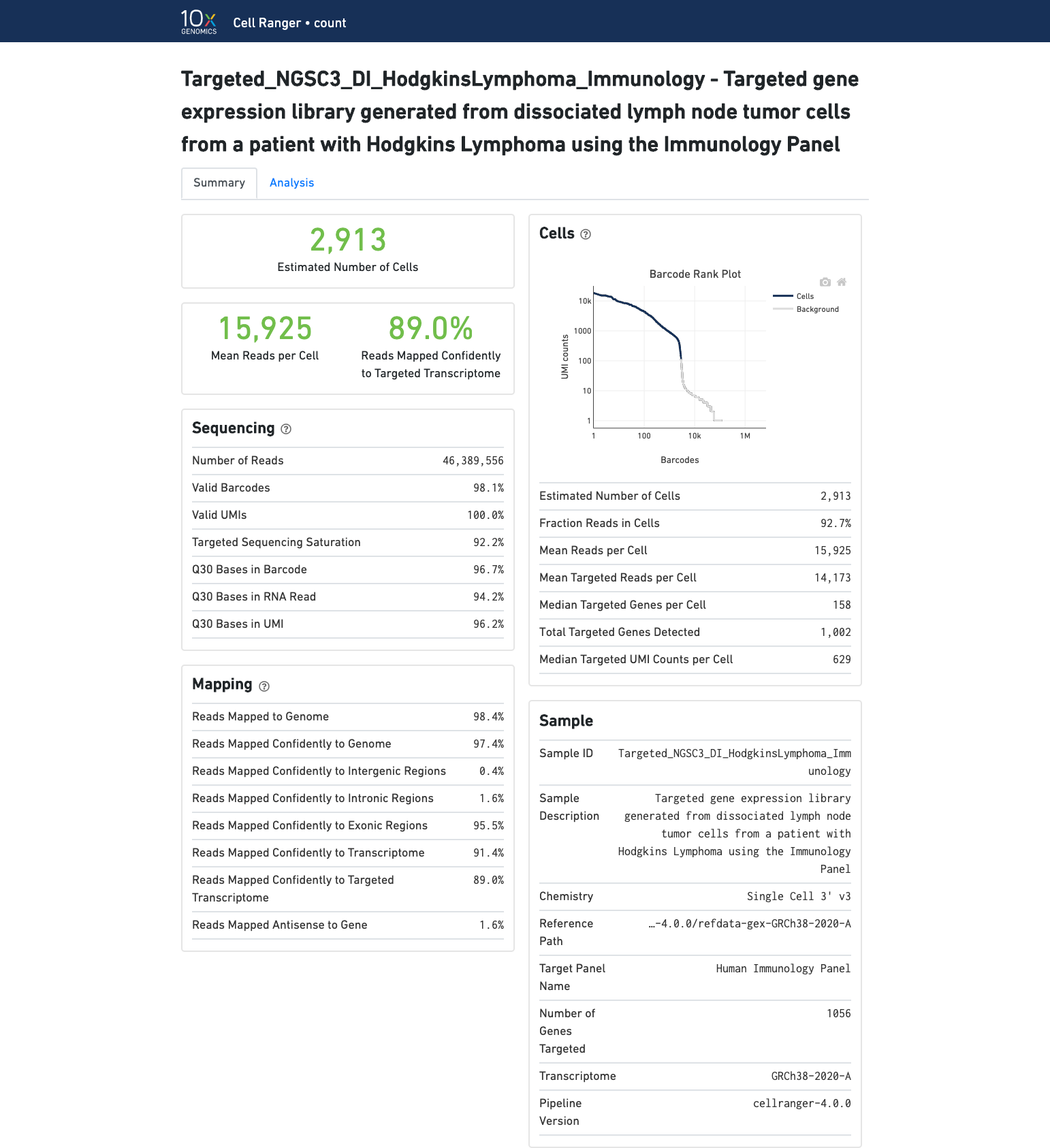
The analysis tab includes a "Targeted Enrichment" dashboard with metrics that assess targeting performance. On the right is a scatterplot of read counts per gene versus UMI counts per gene. A successful targeted experiment where targeted genes are well enriched looks like the one below, with targeted genes (blue) cleanly separable from non-targeted genes (gray). See Targeted Gene Expression Algorithms for more information on how gene enrichments are computed.
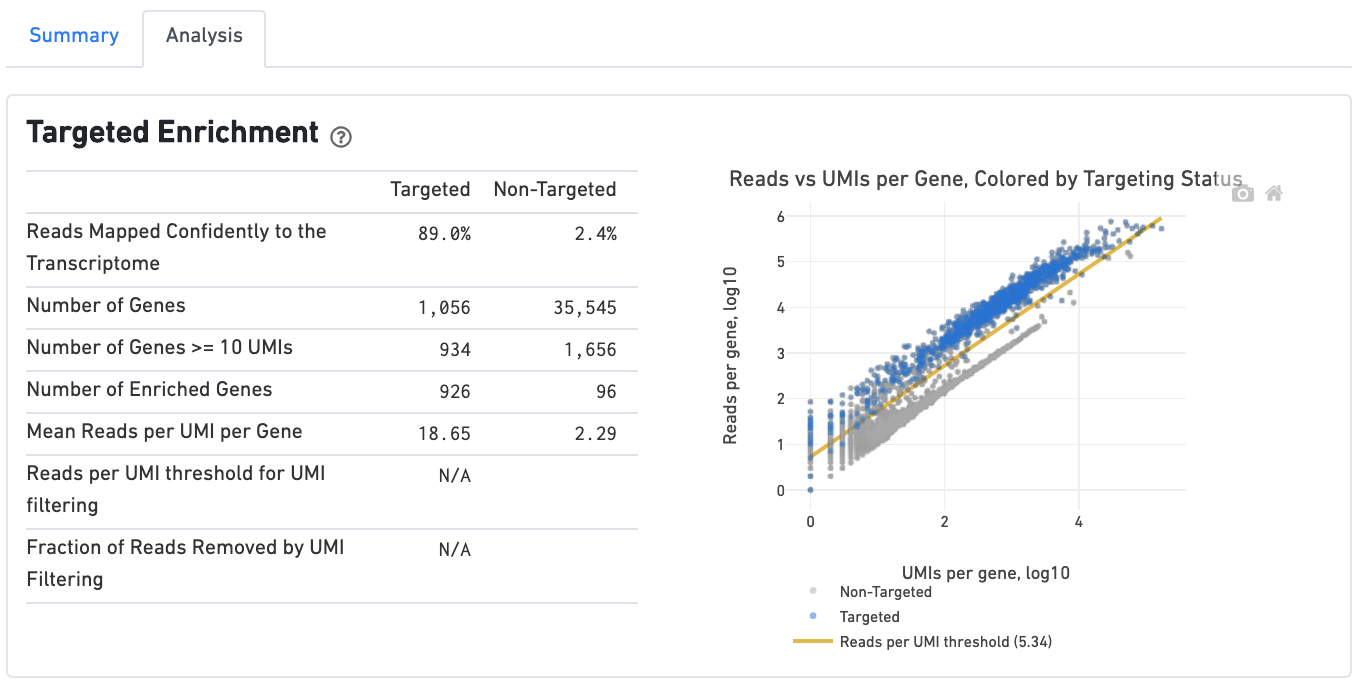
The remainder of the analysis tab is very similar to that of a regular gene expression analysis, but focuses on targeted genes (Sequencing saturation, Median genes per cell). As described under Targeted Gene Expression Analysis, all secondary analysis (t-SNE, differential expression) is done using only targeted genes.
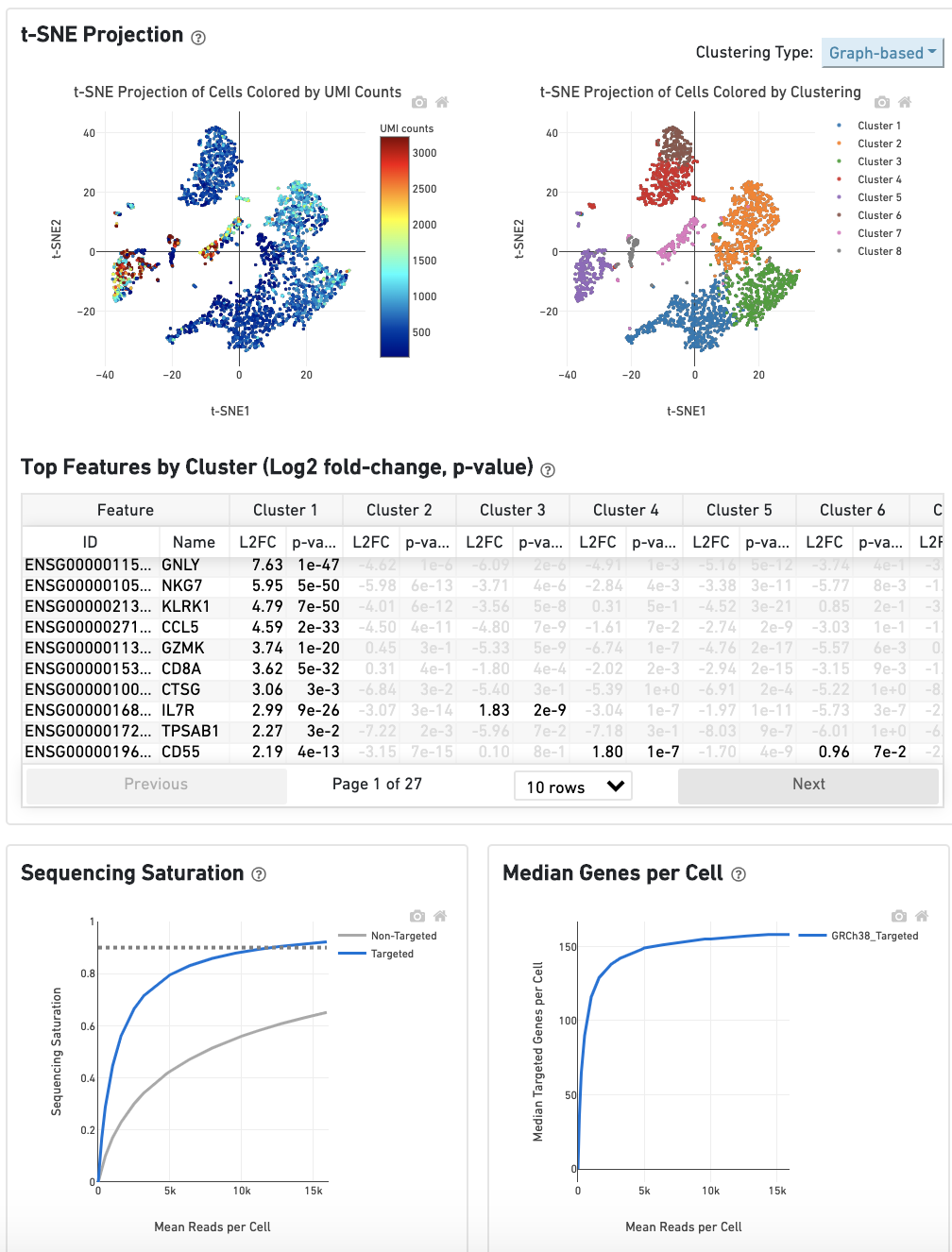
cellranger multi Web Summary
The web_summary.html file is also the starting point for quality control on a Cell Multiplexing experiment run through cellranger multi, introduced in Cell Ranger 6.0. Here is an example from a public dataset consisting of two multiplexed samples representing different cell lines, Jurkat and Raji. On the left, note that there are three views: Sample, Library, and Experimental Design:
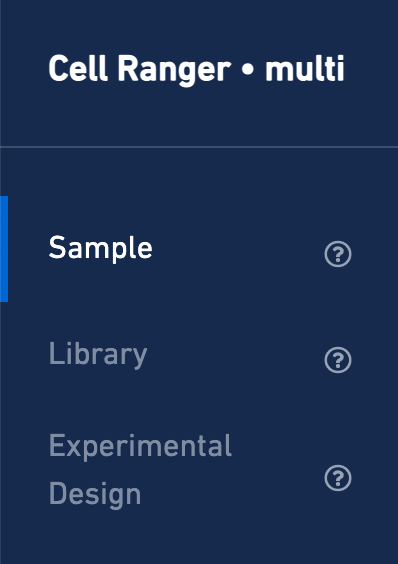
Starting with the Sample view, note key metadata, such as the reagent chemistry, transcriptome version, and reference path:
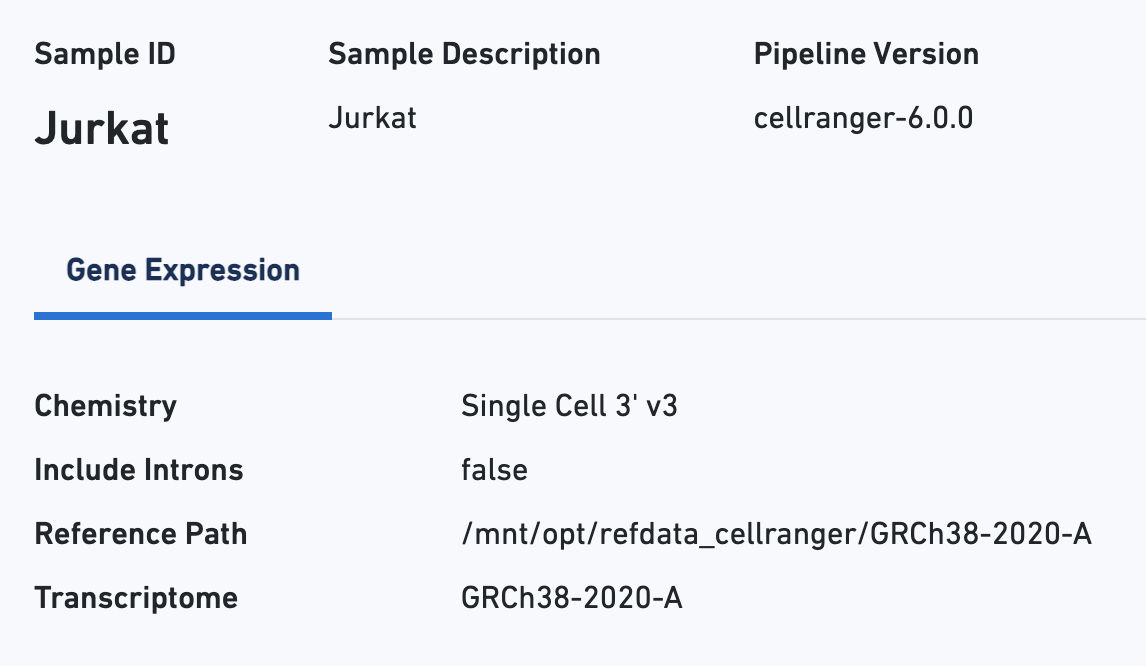
The Cells section contains the most important hero metrics for the sample. The Cell Multiplexing section contains metrics specific to Cell Multiplexing for the sample, and the Mapping Metrics section contains metrics regarding how reads mapped to the reference. Click the question mark "?" symbol to read descriptions for each metric:
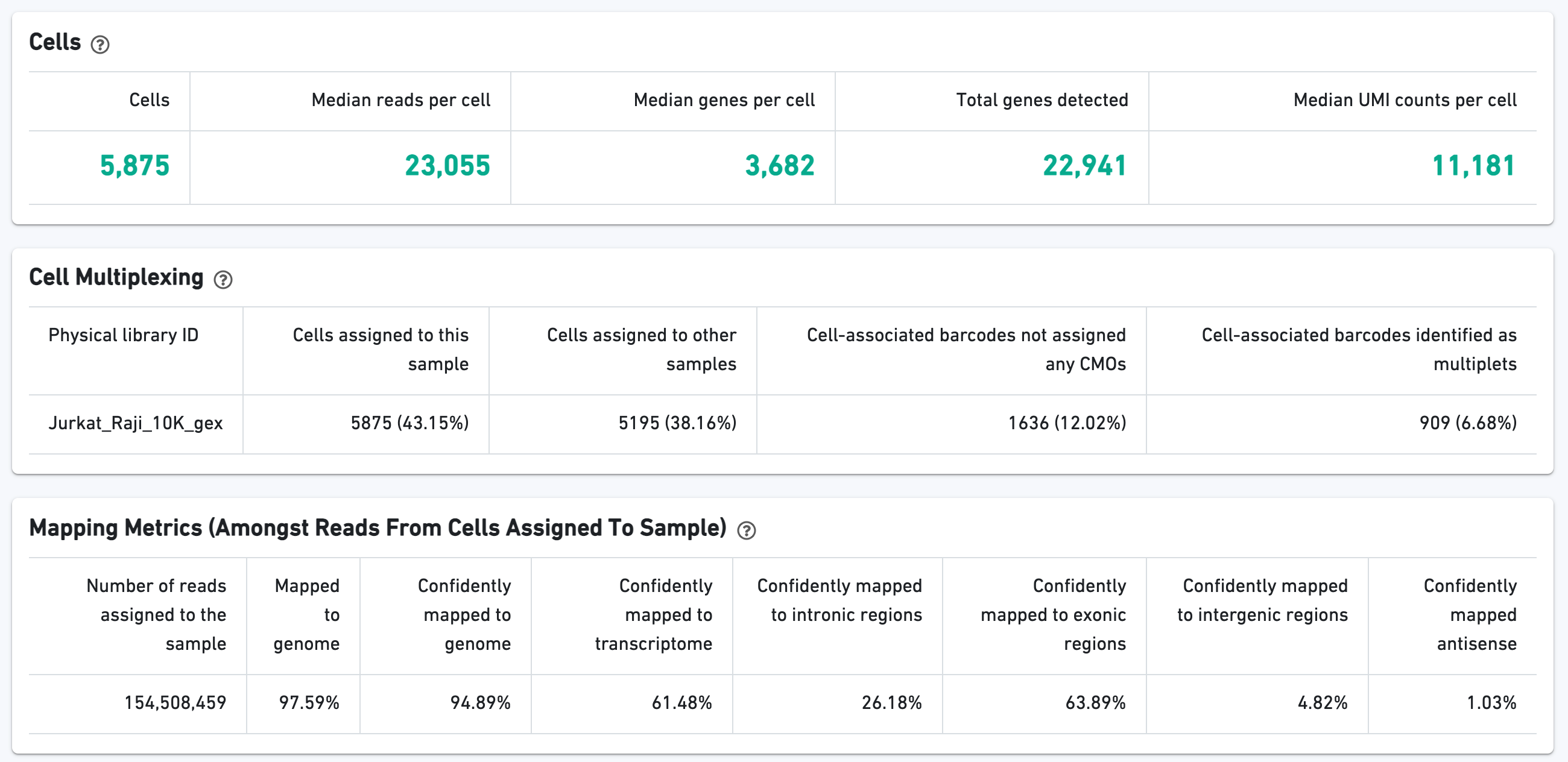
The t-SNE section shows the data reduced to two dimensions, colored by UMI count or clustering (graph-based by default). It is a good starting point to explore structure in the data.
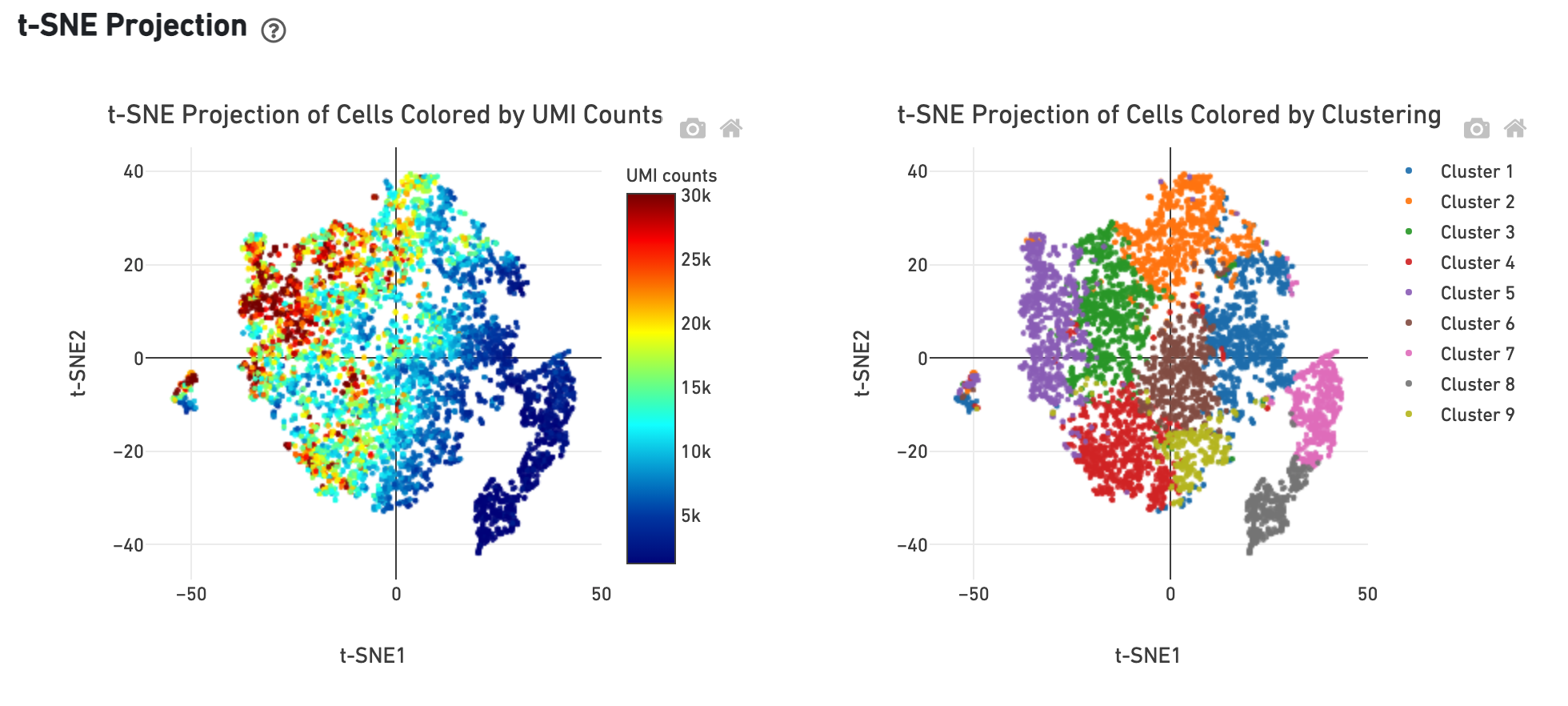
The Top Features by Cluster section shows the results of a differential gene expression analysis among clusters:

The Sequencing Saturation section enables one to gauge whether it is worth sequencing deeper, with diminishing returns of UMIs recovered.
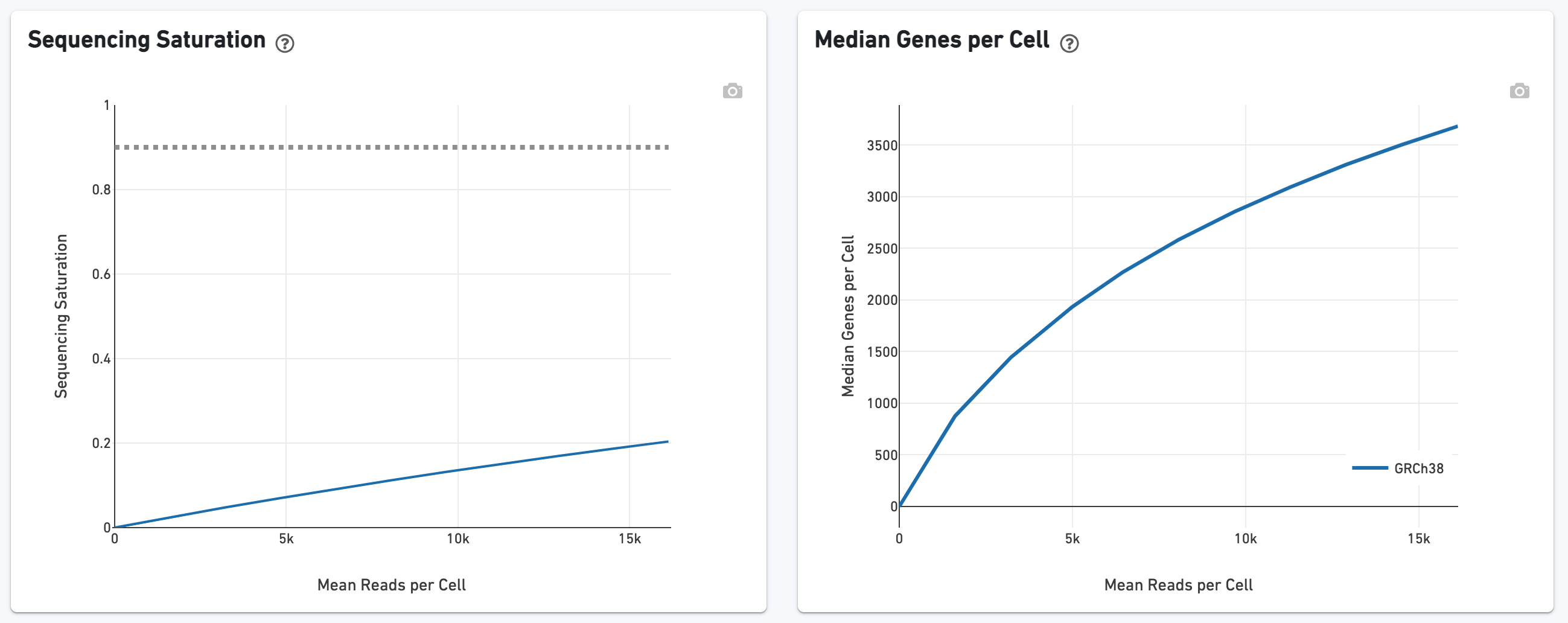
Next switch to the Library view. By default, the Gene Expression tab is toggled to see metrics calculated for the physical library:
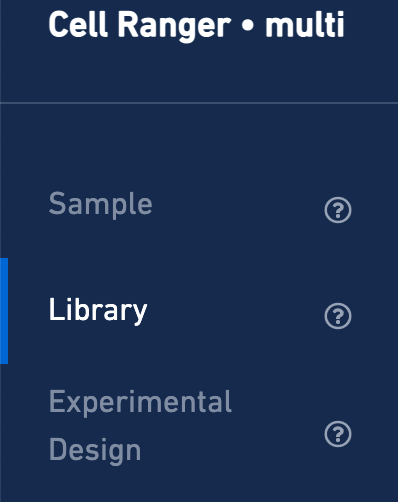
As with the Sample view, metadata for the physical library is displayed on top.
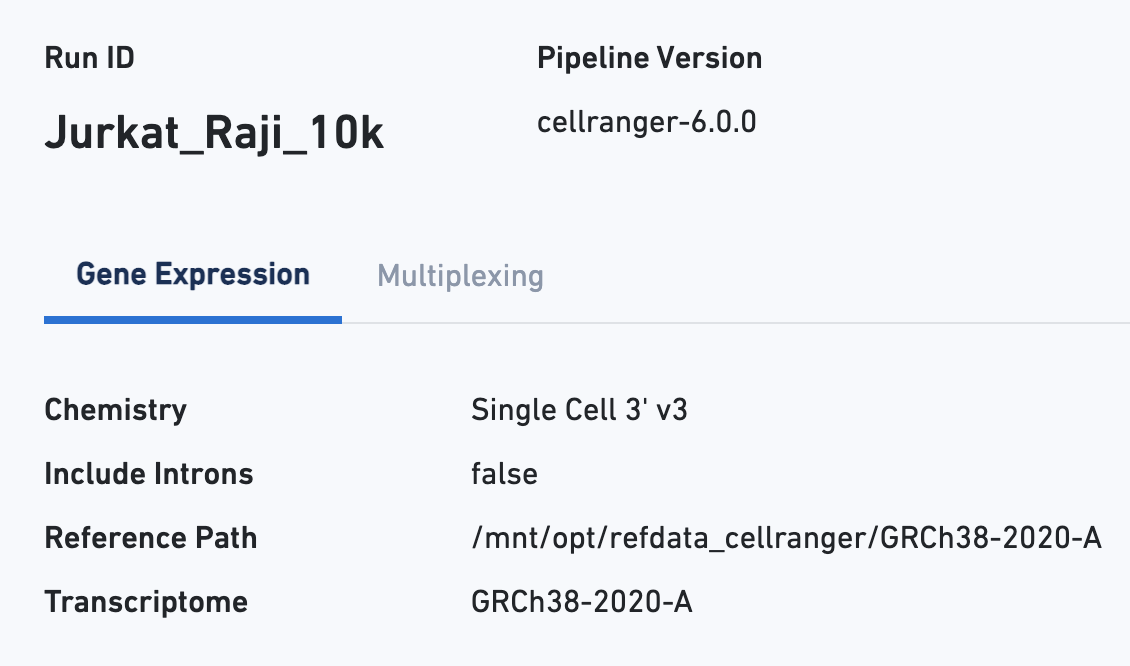
The green hero metrics display the most important results of the experiment:

Additional metrics are displayed below the hero metrics. Click the question mark "?" to read full descriptions for each one.
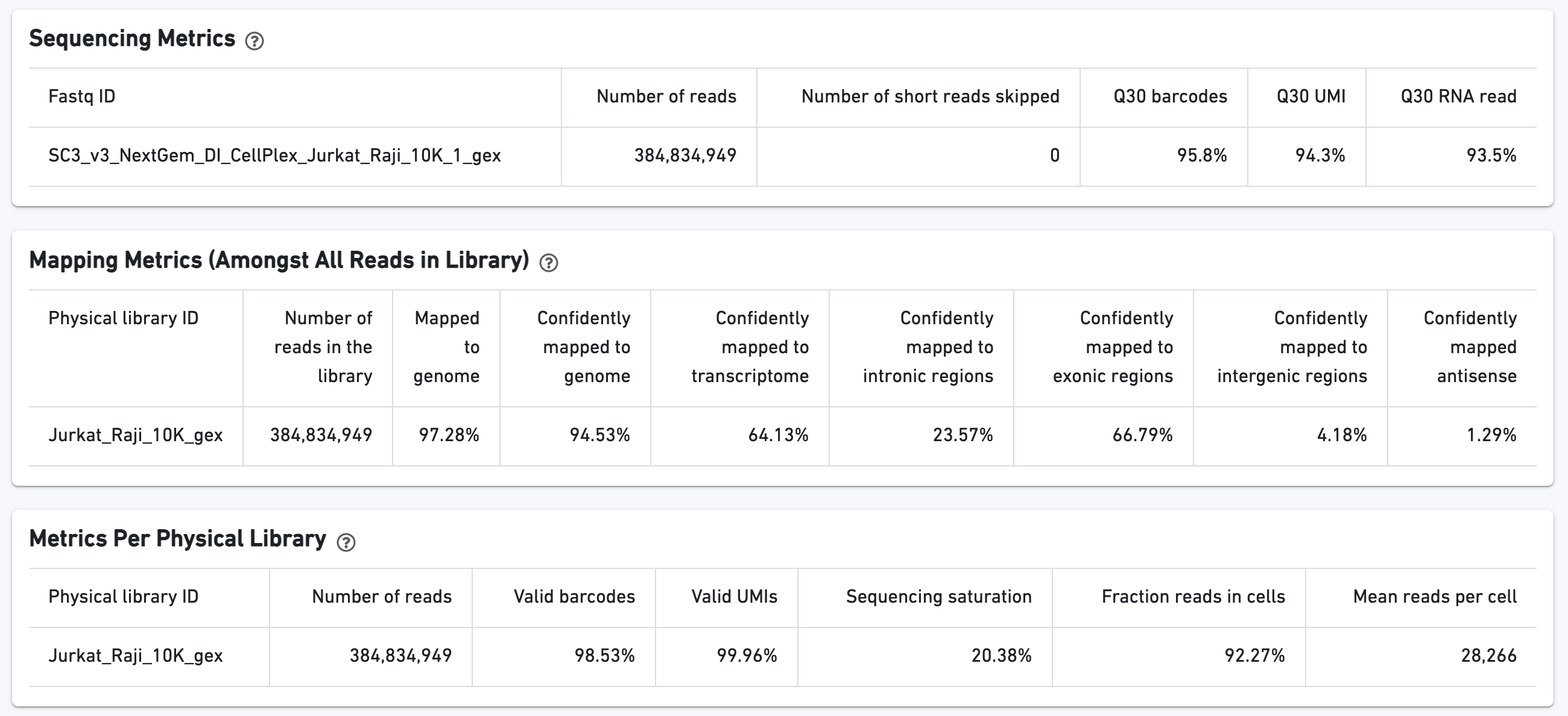
The Ranked Barcode Plot for the gene expression data enables one to assess sample quality. Ideally there is a steep dropoff separating high UMI count cells from low UMI count background noise:
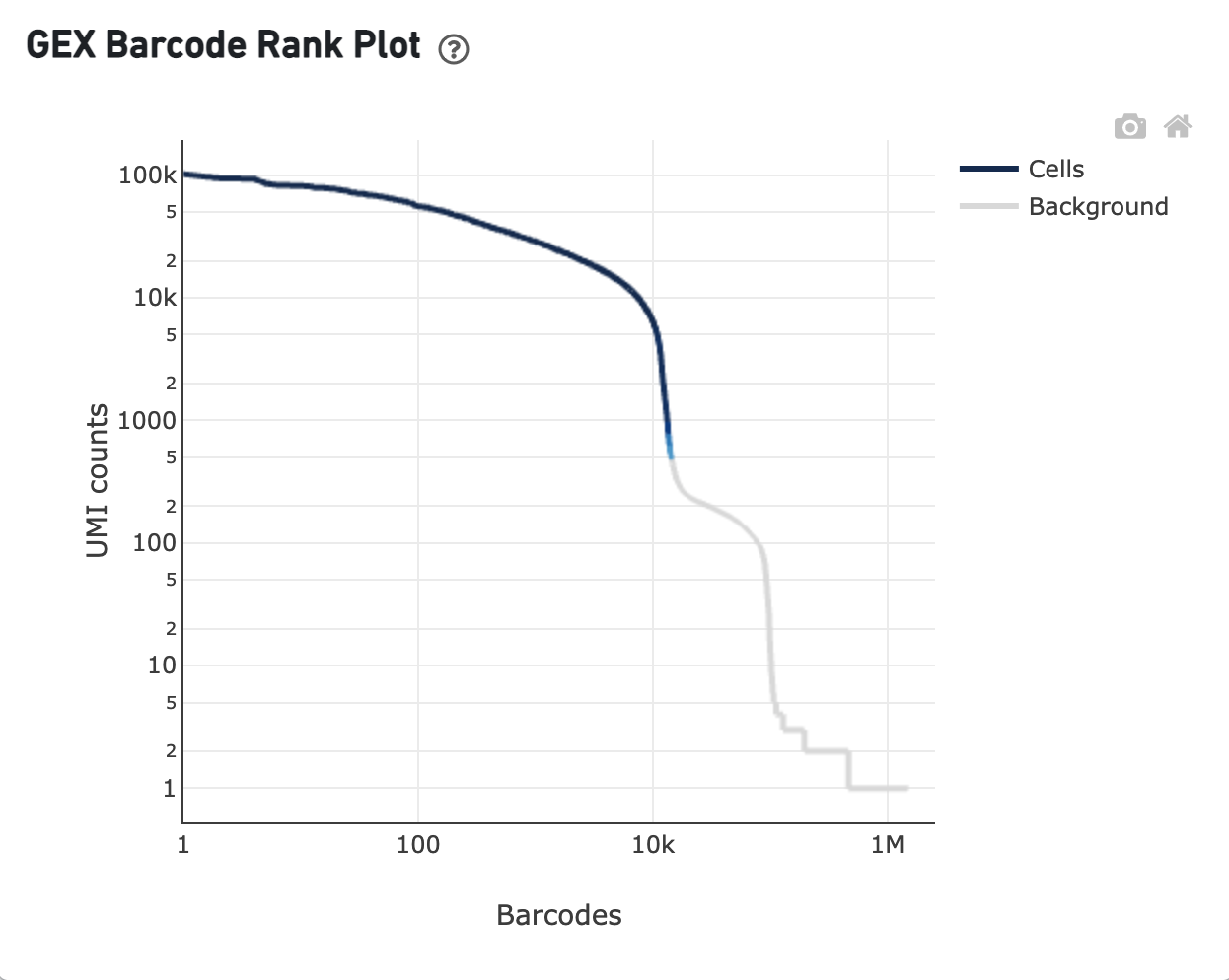
The sequencing saturation plot allows the user to asssess the relative tradeoffs of sequencing deeper or shallower. As sequencing saturation increases, the total number of molecules detected in the library increases, but with diminishing returns as saturation is approached.
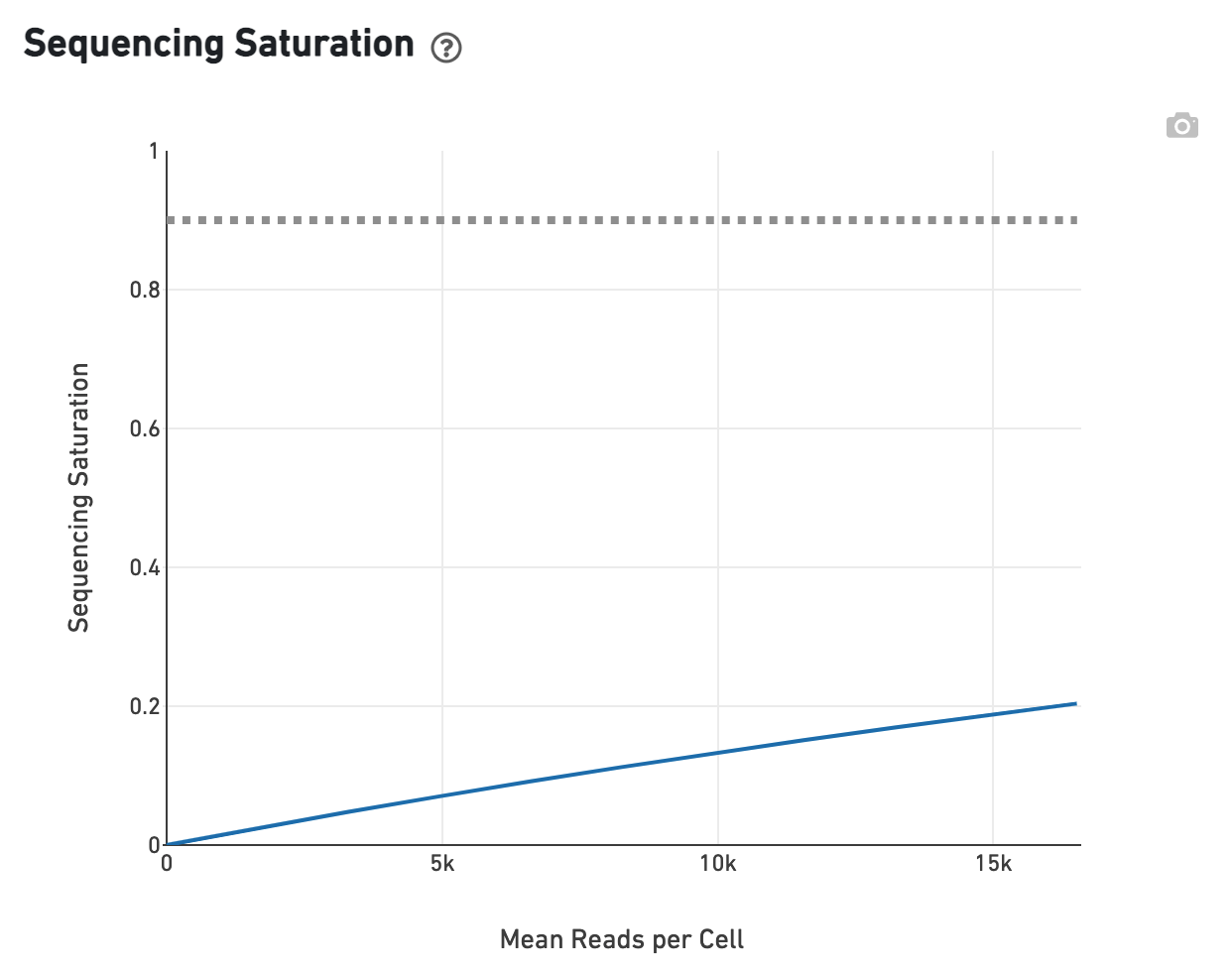
Likewise, one can assess the median genes per cell graph:
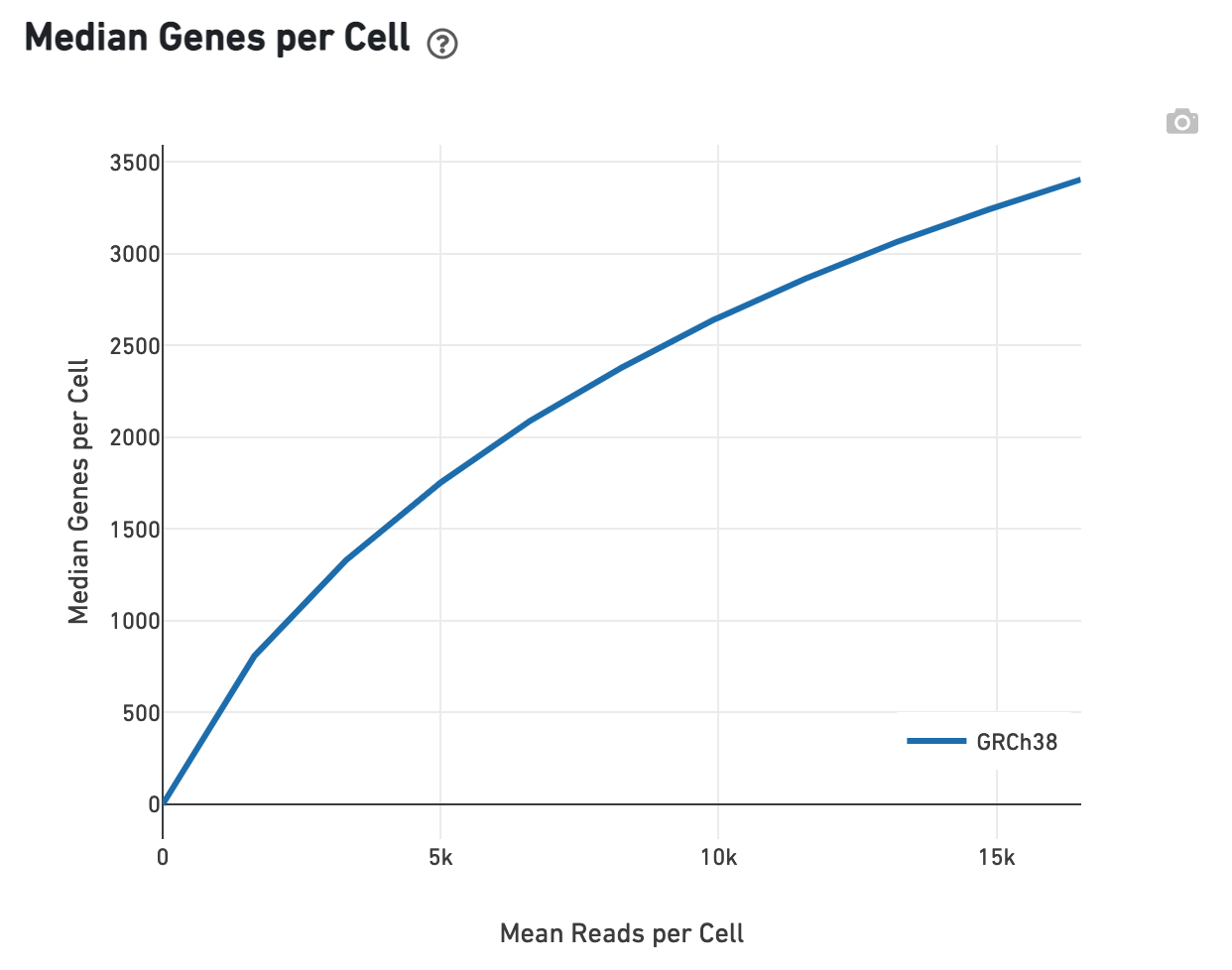
Next click the Multiplexing tab to see metadata and hero metrics for the CMO physical libraries:
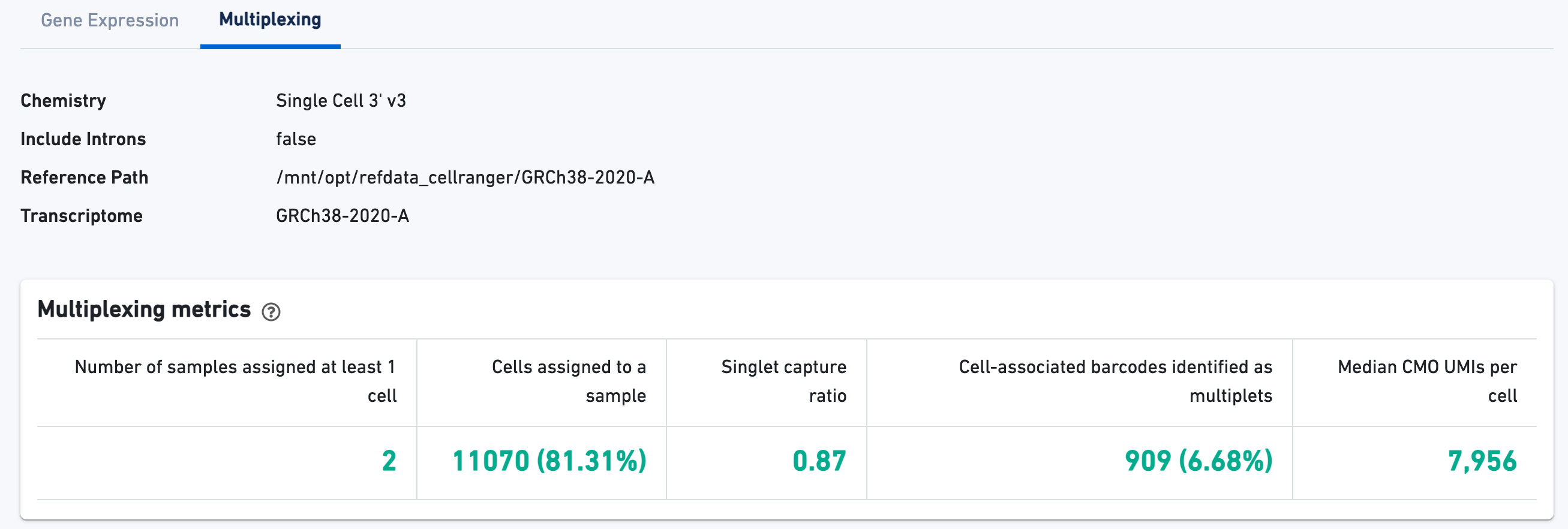
If the experiment went well, the histogram should show a bimodal distribution for each CMO. The left peak should be background noise, while the right peak is signal.
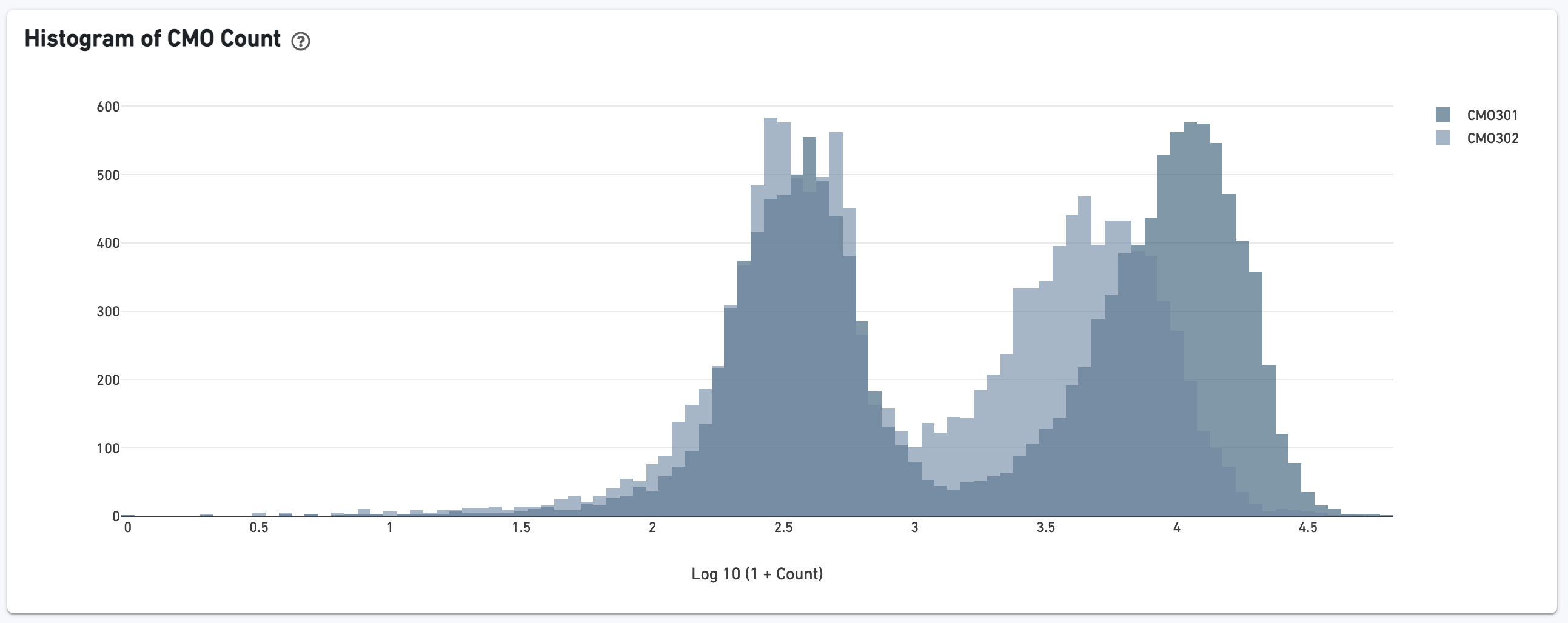
The biplot shows the CMO UMI counts for different cell populations: singlets, multiplets, blanks (not assigned any CMO), or unassigned, which are cells that were not confidently assigned to any of those states. The opacity slider enables the user to minimize overplotting.
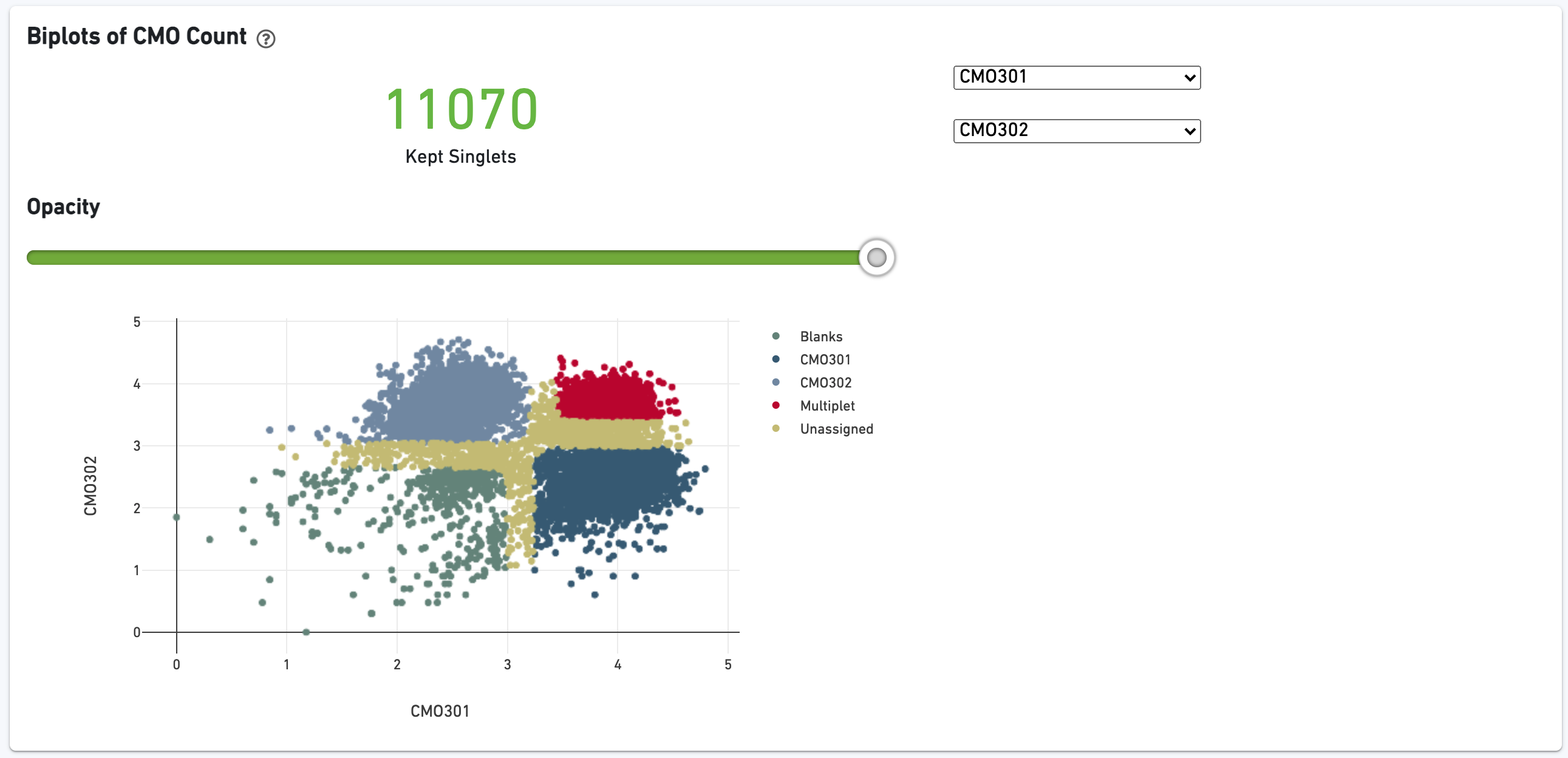
We show a t-SNE projection of just CMO counts, first colored by CMO UMI counts and then colored by CMO assignment. Ideally one would see clear separation between CMO tags.
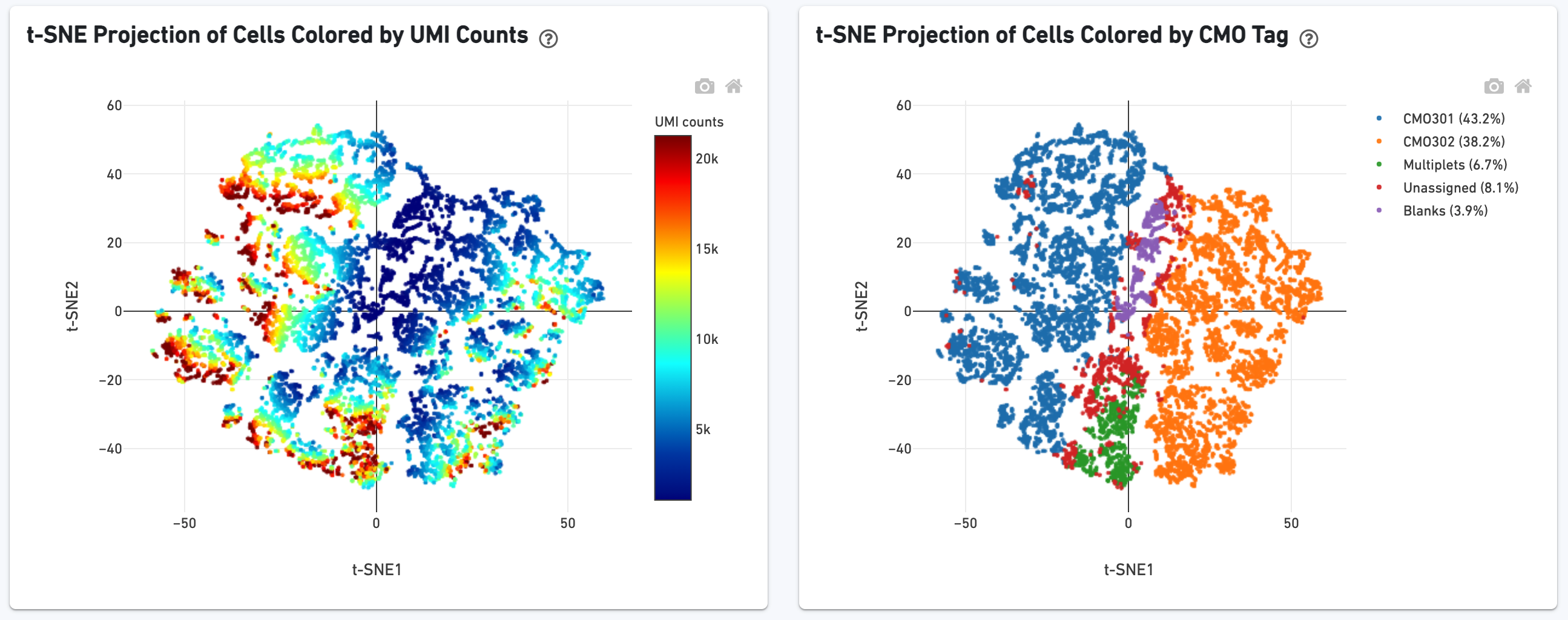
Additional multiplexing sample assignments, sequencing metrics, metrics per physical library, and metrics per CMO are shown:

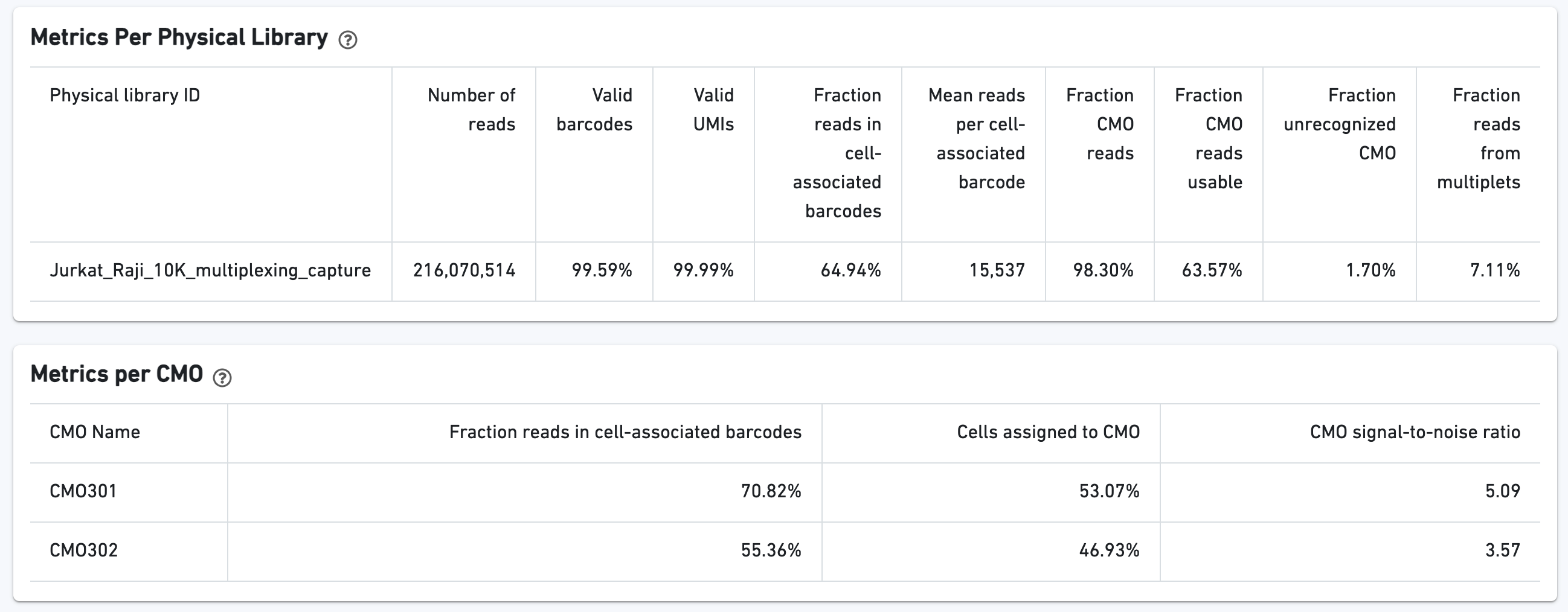
There is a ranked barcode plot to assess the quality of the CMO library. A steep dropoff between cells and background is expected for high quality libraries:
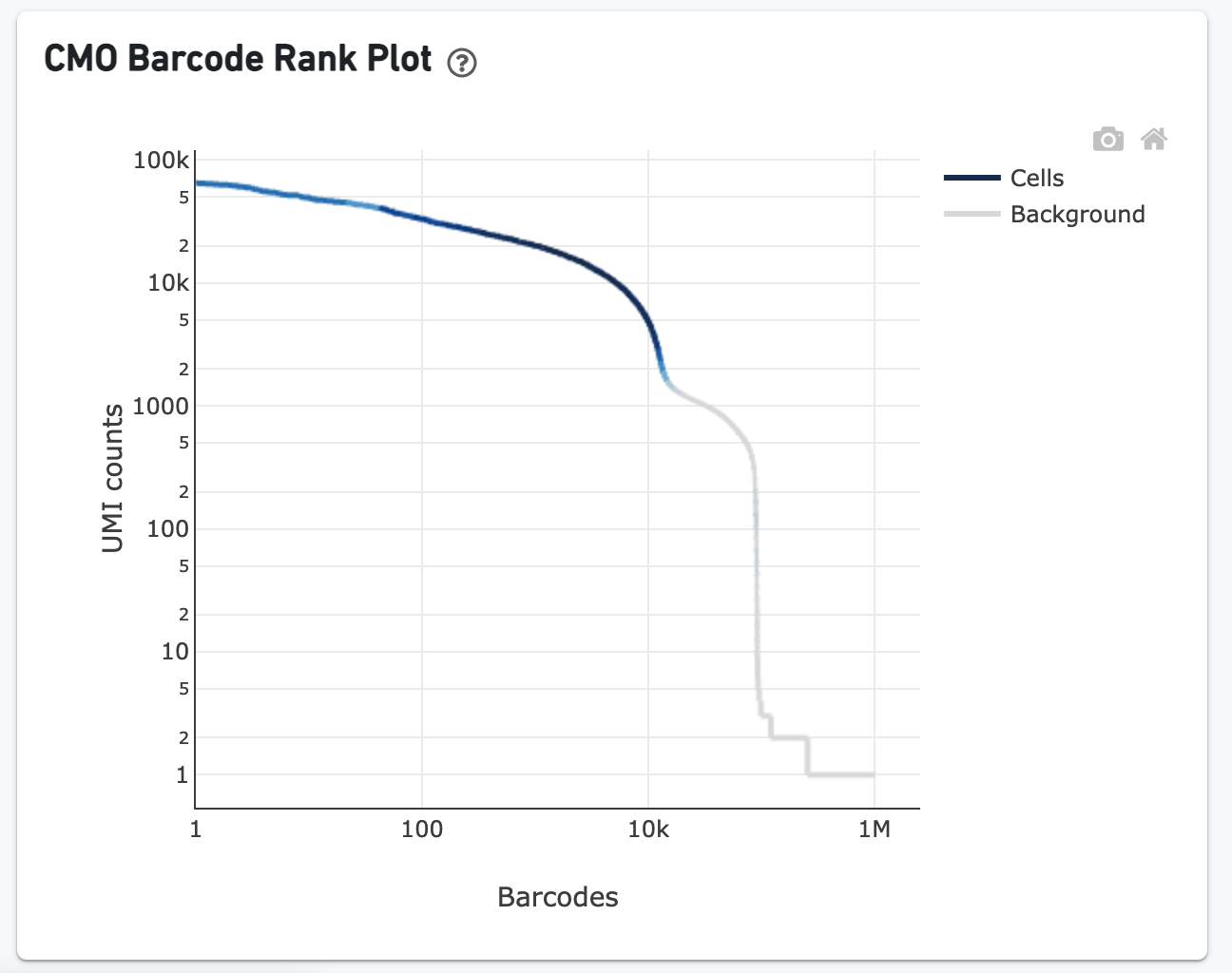
Finally, click the Experimental Design view:
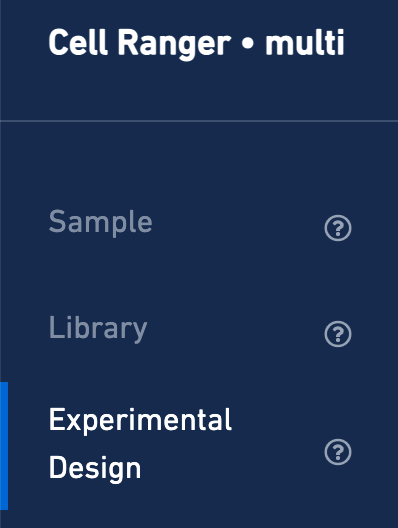
This view enables one to visualize the experimental design for the dataset:
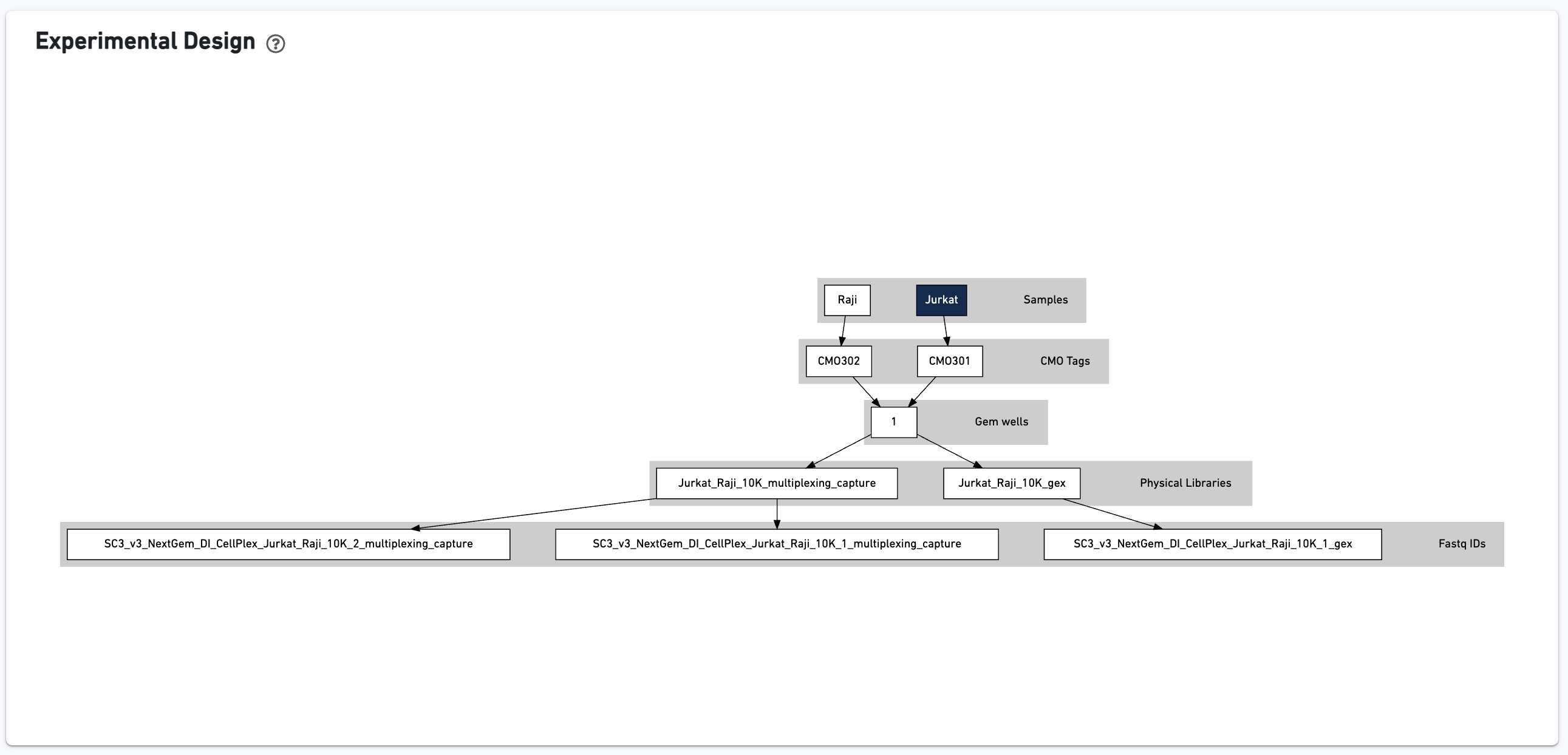
The CSV file is also included for troubleshooting convenience.
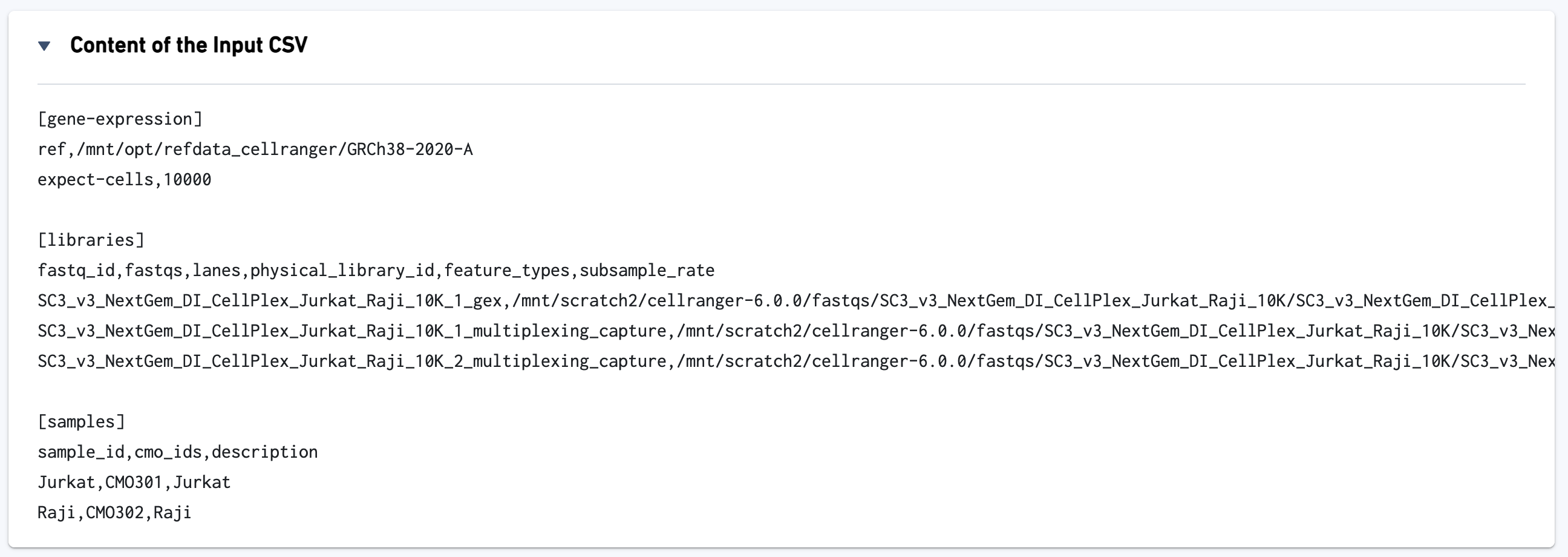
Do you have questions or feedback about this tutorial? Please contact support@10xgenomics.com.